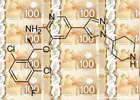 As UHN's monthly research newsletter, NRx reports on the full spectrum of leading research from UHN's five research institutes. Located in downtown Toronto, these institutes are the Princess Margaret (PM) Cancer Centre, the Toronto General Research Institute (TGRI), the Toronto Western Research Institute (TWRI), the Toronto Rehabilitation Institute (TRI) and the Techna Institute (Techna).
As UHN's monthly research newsletter, NRx reports on the full spectrum of leading research from UHN's five research institutes. Located in downtown Toronto, these institutes are the Princess Margaret (PM) Cancer Centre, the Toronto General Research Institute (TGRI), the Toronto Western Research Institute (TWRI), the Toronto Rehabilitation Institute (TRI) and the Techna Institute (Techna).
In this issue you can read about:
- An Antimalarial Therapy that may Protect against Brain Damage
- Out-of-Pocket Costs for Prostate Cancer Survivors
- Measuring Physical Fitness with Brain Imaging
- Cost Analyses of an Anticancer Therapy
- The New Director for UHN Research Commercialization
- UHN's Award Winning 2013 Research Report
We hope that you will find NRx informative. If you have feedback or questions, please contact www@uhnresearch.ca.
Christopher J. Paige, PhD, FCAHS
Vice President, Research
University Health Network

Children under 15 years of age make up close to 65% of all those infected with malaria globally.
Of all diseases, malaria represents one of the greatest global health threats. Its most severe form, known as cerebral malaria, occurs when blood cells infected with the malaria parasite accumulate in the brain and block blood flow, leading to tissue damage—a condition that is particularly devastating in children, as it can lead to death in 20% of those infected and long-term brain damage in those that survive.
TGRI Senior Scientist Dr. Kevin Kain and Assistant Scientist Dr. Lena Serghides are exploring a promising new class of compounds to treat cerebral malaria, known as PPAR-γ (Peroxisome proliferator-activated receptor-γ) agonists. While preliminary evidence suggests that these compounds may promote the body's ability to clear infected blood cells and reduce harmful inflammation, it is still unclear at the molecular level how these drugs may act to protect brain tissues.
The study involved an experimental model and a clinical trial to explore the impact of these drugs when used in combination with standard anti-malarial therapy. In the experimental model, the team found that combination therapy was able to improve survival and completely protect against neurocognitive impairment, while in human patients, molecular pathways involved in neuroprotection were shown to be enhanced.
Dr. Kain comments, "This study provides a compelling case for further exploration of the potential benefit of PPAR-γ agonists in the prevention and treatment of the most deadly form of malaria."
Supported by the Grand Challenge Canada Stars in Global Health, the Defense Advanced Research Projects Agency, the Canadian Institutes of Health Research and the Toronto General & Western Hospital Foundation. K Kain holds a Tier 1 Canada Research Chair in Molecular Parasitology.
PPARγ agonists improve survival and neurocognitive outcomes in experimental cerebral malaria and induce neuroprotective pathways in human malaria. Serghides L, McDonald CR, Lu Z, Friedel M, Cui C, Ho KT, Mount HT, Sled JG, Kain KC. PLoS Pathogens. 2014 March 6. [Pubmed abstract]

Ontario patients often pay for services not covered by provincial health insurance, including those associated with allied health services, complementary or alternative medicines.
Prostate cancer is one of the most common types of cancer among men in developed countries. Because of early detection and effective treatment, patients may now live for many years after being diagnosed. These long-term survivors often continue to experience the adverse side effects of treatments—effects that may be associated with added economic costs. While all Ontario residents have publicly funded health care insurance, some services are not covered and must be paid out-of-pocket (OOP).
A recent study by TGRI Senior Scientists Drs. Murray Krahn and Shabbir Alibhai, along with researchers at the Centre for Addiction and Mental Health and the University of Toronto, examined the time (cost of time lost due to associated illness) and OOP costs for a sample of long-term prostate cancer survivors in Ontario. By analyzing data from questionnaires and chart reviews, the study showed that mean time costs were $838/year and mean OOP costs were $200/year. Moreover, the study identified factors that significantly increased the likelihood of incurring any costs, including whether patients were younger, had poor urinary function, were recently diagnosed, had a radical prostatectomy or were currently undergoing androgen deprivation therapy.
"These costs are generally manageable for these long-term survivors," indicates Dr. Krahn. "However, they were approximately 10% of annual income for lower income patients and thus represent a significant economic burden to this group."
This study was supported by the Canadian Institutes of Health Research, the National Cancer Institute of Canada and the Toronto General & Western Hospital Foundation.
Patient time and out-of-pocket costs for long-term prostate cancer survivors in Ontario, Canada. De Oliveira C, Bremner KE, Ni A, Alibhai SMH, Laporte A, Krahn MD. Journal of Cancer Survivorship. 2014 March. [Pubmed abstract]

Brain structure and regional blood flow reveal new ways that fitness benefits the brain, predicting who will benefit most from exercise.
A new study led by TRI Affiliate Scientist Dr. Krista Lanctôt, postdoctoral fellow Dr. Walter Swardfager and Dr. Bradley MacIntosh has uncovered new associations between physical fitness and brain structure, which may be useful in measuring the effects of exercise on patients with coronary artery disease (CAD).
The study used magnetic resonance imaging (MRI) scans of patients with CAD, taken around the time of an initial exercise test, and compared them to MRI scans taken after six months of physical training. Analysis of these results revealed that cardiovascular fitness was strongly associated with an increase in blood flow to the brain. Fitness was also correlated with an increase in grey matter in specific regions of the brain, which are involved in memory, motor learning and reward.
“These results suggest that MRI scans could potentially be used to monitor changes in physical fitness,” says Dr. Lanctôt. “This would help to identify which patients with coronary artery disease are benefiting most from participation in exercise-based cardiac rehabilitation programs.”
This work was supported by Canadian Institutes of Health Research, the Heart and Stroke Foundation Centre for Stroke Recovery and the Toronto Rehab Foundation.
Cardiopulmonary fitness correlates with regional cerebral grey matter perfusion and density in men with coronary artery disease. Macintosh BJ, Swardfager W, Crane DE, Ranepura N, Saleem M, Oh PI, Stefanovic B, Herrmann N, Lanctôt KL. PLoS One. 2014 March 12. [Pubmed abstract]

Crizotinib increased survival in lung cancer clinical trials, but costs for the treatment were $7,000 CAD per three-week cycle.
Cancer researchers have identified specific gene mutations to classify cancer into sub-types. As our understanding of the genomic component of cancer has improved over the years, drugs that target the underlying mechanisms have been developed. Genomic testing can identify those patients who are most likely to benefit. This form of personalized cancer medicine has the potential to improve health care costs by ensuring that only those patients that benefit receive the drug; however, in some cases targeted treatments can be extremely expensive.
A recent study by PM Clinical Researcher Dr. Natasha Leighl and colleagues studied the costs and benefits associated with crizotinib—a drug that targets non-small-cell lung cancer tumours with a specific genomic profile (EML-4 ALK rearrangement).
Using a model of the drug’s effectiveness based on data collected in previous studies and the Ontario Cancer Registry, the researchers estimated that it would cost over $250,000 per year of productive life saved, which is not considered cost effective by the Canadian public healthcare system. Even when rigorous cost-saving strategies were factored in, the high price of the drug meant the overall result was still cost-prohibitive. Health economics studies such as this one help provide an objective basis for deciding which new medications the province can afford to pay for. Fortunately this new drug is now available for lung cancer patients in Ontario thanks to a collaboration between the province and the drug manufacturer.
This study was supported by Cancer Care Ontario, the Princess Margaret Division of Medical Oncology and The Princess Margaret Cancer Foundation.
Cost effectiveness of EML4-ALK fusion testing and first-line crizotinib treatment for patients with advanced ALK-positive non-small-cell lung cancer. Djalalov S, Beca J, Hoch JS, Krahn M, Tsao MS, Cutz JC, Leighl NB. Journal of Clinical Oncology. 2014 February 24. [Pubmed abstract]

UHN is pleased to introduce Dr. John Reid as the new Director of UHN's Technology Development and Commercialization (TDC) office (effective March 3, 2014). He is a global leader in drug research and development, with numerous career accomplishments in science and business, including the prestigious Deal of Distinction Award from the Licensing Executive Society in 2008 and 2010.
Dr. Reid received his PhD from the University of California, Berkeley; a degree in Business Development from the Wharton School at the University of Philadelphia; and his MBA from the Le Bow College of Business at Drexel University. Before joining UHN, he held a number of scientific and business positions at leading pharmaceutical companies including AstraZeneca, GlaxoWellcome (currently GlaxoSmithKline) and Genentech. Moreover, he founded and operated a consulting company, Entrepid Business Development, to help biopharmaceutical companies develop global licensing and partnering agreements.
In his new role, Dr. Reid will guide UHN into its next phase of growth and performance by transforming business development capabilities and skills, strengthening the TDC Office's relationships with the research community, increasing UHN's scope and reach of deal-making and helping to establish UHN as a partner of choice in commercialization.

UHN's 2013 Research Report has received a Platinum Award in the 2012/13 League of American Communications Professionals (LACP) Vision Awards Annual Report Competition. The report titled, Seeing Beyond: Achieving Health was also ranked 1st within the Health Care Providers & Services class and 22nd out of the over 6,000 submissions—entries that hailed from more than 24 countries and 800 organizations around the globe.
LACP Managing Director, Christine Kennedy commented that the report "proves to be remarkable in light of tremendous competition," and earned "a total score of 99 out of a maximum 100 points." The report was also judged to have an exceptional cover, welcome message, narrative, financials and "clarity in communicating this year's key messages."
Written and designed in-house by the UHN Research Communications department with input from other RSS departments including Research Program & Planning Analysis, Research Financial Services and Research Facilities Planning & Safety, the report highlights leading research advancements, news, funding, financials and stories from our sister Foundations.
To view the report, click here.
 Dr.
Dr.  TGRI Scientist Dr.
TGRI Scientist Dr.